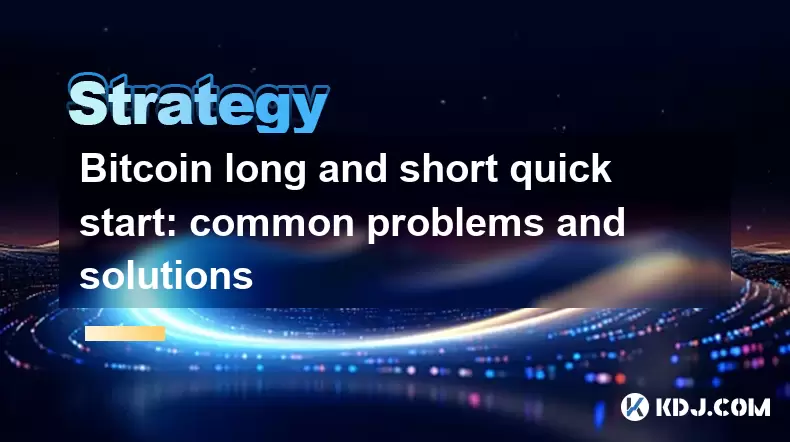-
 bitcoin
bitcoin $122288.232522 USD
0.16% -
 ethereum
ethereum $4480.662914 USD
-0.22% -
 xrp
xrp $2.962747 USD
-2.32% -
 tether
tether $1.000120 USD
-0.05% -
 bnb
bnb $1145.654223 USD
-2.07% -
 solana
solana $227.105217 USD
-1.67% -
 usd-coin
usd-coin $0.999548 USD
-0.02% -
 dogecoin
dogecoin $0.250875 USD
-2.04% -
 tron
tron $0.340654 USD
-0.49% -
 cardano
cardano $0.837968 USD
-2.52% -
 hyperliquid
hyperliquid $48.960449 USD
0.06% -
 chainlink
chainlink $22.049280 USD
-1.33% -
 ethena-usde
ethena-usde $1.000404 USD
0.02% -
 sui
sui $3.586212 USD
0.20% -
 avalanche
avalanche $29.894916 USD
-4.18%
Bitcoin long and short quick start: common problems and solutions
Bitcoin long and short trading involves betting on price rises or falls, using exchanges like Binance, and managing risks with stop-loss orders and trading plans.
Jun 10, 2025 at 10:14 pm

Bitcoin trading, particularly engaging in long and short positions, can be an exhilarating yet complex venture for newcomers and seasoned traders alike. Understanding the basics of going long or short on Bitcoin, along with common problems and their solutions, is crucial for anyone looking to navigate the volatile cryptocurrency markets effectively. This article aims to provide a comprehensive quick start guide to Bitcoin long and short trading, addressing frequent issues and offering practical solutions.
Understanding Long and Short Positions in Bitcoin Trading
Long Position: When you go long on Bitcoin, you are essentially betting that the price of Bitcoin will rise. You purchase Bitcoin with the expectation of selling it at a higher price in the future. This is the most straightforward form of trading and is often what people think of when they consider investing in cryptocurrencies.
Short Position: Conversely, going short on Bitcoin means you are betting that the price will fall. Short selling involves borrowing Bitcoin, selling it at the current market price, and then buying it back later at a lower price to return to the lender, pocketing the difference as profit. This strategy can be riskier but offers the potential for profit in a declining market.
Setting Up for Bitcoin Long and Short Trading
To begin trading Bitcoin in long and short positions, you will need to set up an account on a reputable cryptocurrency exchange that supports margin trading. Here are the steps you need to follow:
- Choose a Suitable Exchange: Select an exchange that offers robust trading features, including margin trading. Examples include Binance, Kraken, and BitMEX.
- Complete KYC/AML Procedures: Most exchanges require you to complete Know Your Customer (KYC) and Anti-Money Laundering (AML) checks to comply with regulations.
- Deposit Funds: Fund your account with either fiat currency or cryptocurrency. Ensure you have enough capital to cover potential losses.
- Enable Margin Trading: Navigate to the margin trading section of the exchange and enable it. This might require you to agree to additional terms and conditions.
Common Problems When Going Long on Bitcoin
Problem: Market Volatility: Bitcoin is known for its high volatility, which can lead to significant price swings. This can be particularly challenging when holding a long position.
Solution: Use stop-loss orders to limit potential losses. A stop-loss order automatically sells your Bitcoin if the price drops to a certain level, helping to protect your investment.
Problem: Emotional Trading: Many traders fall prey to emotional decisions, buying at market peaks out of FOMO (Fear Of Missing Out) or panic selling during downturns.
Solution: Develop a trading plan with clear entry and exit points and stick to it. Avoid making impulsive decisions based on short-term market movements.
Common Problems When Going Short on Bitcoin
Problem: Unlimited Loss Potential: Unlike going long, where the maximum loss is the amount invested, short selling has theoretically unlimited loss potential if the price of Bitcoin rises significantly.
Solution: Set a stop-loss order to limit potential losses. Additionally, consider using options or futures contracts to cap potential losses while maintaining the possibility of profiting from a price decline.
Problem: Margin Calls: If the market moves against your short position, you might receive a margin call, requiring you to deposit more funds to maintain your position.
Solution: Monitor your positions closely and have a plan in place to either add more funds or close the position if a margin call occurs. Always trade with funds you can afford to lose.
Executing Long and Short Trades on Bitcoin
Once you have set up your trading account and enabled margin trading, executing long and short trades involves the following steps:
- Going Long:
- Navigate to the Bitcoin trading pair on your exchange.
- Place a buy order at your desired price.
- Monitor the market and decide when to sell based on your trading plan.
- Going Short:
- Navigate to the Bitcoin trading pair on your exchange.
- Place a sell order to short Bitcoin at your desired price.
- Monitor the market and decide when to buy back Bitcoin to close your position based on your trading plan.
Technical Analysis and Tools for Bitcoin Trading
Technical analysis is crucial for making informed trading decisions, whether going long or short on Bitcoin. Here are some essential tools and techniques:
Candlestick Charts: These charts provide a visual representation of price movements over time, helping you identify patterns and trends.
Moving Averages: Use moving averages to smooth out price data and identify the direction of the trend. Common types include the Simple Moving Average (SMA) and the Exponential Moving Average (EMA).
Relative Strength Index (RSI): The RSI is a momentum oscillator that measures the speed and change of price movements. It can help you identify overbought or oversold conditions.
Volume Analysis: Analyzing trading volume can provide insights into the strength of a price move. High volume during a price increase might indicate strong buying pressure.
Frequently Asked Questions
Q1: Can I go long and short on Bitcoin at the same time?A1: Yes, it is possible to have both long and short positions on Bitcoin simultaneously. This strategy is known as a hedge and can help mitigate risk. For example, if you hold a long position and the market starts to decline, you could open a short position to offset potential losses.
Q2: What is the difference between spot trading and margin trading for Bitcoin?A2: Spot trading involves buying and selling Bitcoin for immediate delivery, while margin trading allows you to borrow funds to increase your trading position. Margin trading can amplify both gains and losses, making it riskier than spot trading.
Q3: How do I choose the right leverage for Bitcoin trading?A3: Choosing the right leverage depends on your risk tolerance and trading strategy. Higher leverage can increase potential profits but also magnifies potential losses. Start with lower leverage to understand the market dynamics better and gradually increase it as you gain more experience.
Q4: Are there any fees associated with going long and short on Bitcoin?A4: Yes, trading fees are typically associated with both long and short positions. These can include exchange fees, borrowing fees for short positions, and potential interest on borrowed funds. Always check the fee structure of your chosen exchange before trading.
Disclaimer:info@kdj.com
The information provided is not trading advice. kdj.com does not assume any responsibility for any investments made based on the information provided in this article. Cryptocurrencies are highly volatile and it is highly recommended that you invest with caution after thorough research!
If you believe that the content used on this website infringes your copyright, please contact us immediately (info@kdj.com) and we will delete it promptly.
- BlockDAG, DOGE, HYPE Sponsorship: Crypto Trends Shaping 2025
- 2025-10-01 00:25:13
- Deutsche Börse and Circle: A StableCoin Adoption Powerhouse in Europe
- 2025-10-01 00:25:13
- BlockDAG's Presale Buzz: Is It the Crypto to Watch in October 2025?
- 2025-10-01 00:30:13
- Bitcoin, Crypto, and IQ: When Genius Meets Digital Gold?
- 2025-10-01 00:30:13
- Stablecoins, American Innovation, and Wallet Tokens: The Next Frontier
- 2025-10-01 00:35:12
- NBU, Coins, and Crypto in Ukraine: A New Yorker's Take
- 2025-10-01 00:45:14
Related knowledge

Practical parameter settings for a Bitcoin multi-timeframe moving average system
Sep 18,2025 at 10:54pm
Optimizing Timeframe Combinations for Bitcoin Trading1. Selecting appropriate timeframes is crucial when building a multi-timeframe moving average sys...

How can I filter out false breakouts in Dogecoin high-frequency trading?
Sep 22,2025 at 01:00am
Understanding False Breakouts in Dogecoin Trading1. A false breakout occurs when Dogecoin's price appears to move beyond a defined support or resistan...

Techniques for identifying tops and bottoms in the Bitcoin on-chain NVT model
Sep 20,2025 at 07:54pm
Understanding the NVT Model in Bitcoin Analysis1. The Network Value to Transactions (NVT) ratio is often described as the 'P/E ratio' of the cryptocur...

What does the surge in open interest in Bitcoincoin futures mean?
Sep 20,2025 at 11:18pm
Understanding the Surge in Dogecoin Futures Open Interest1. A surge in open interest within Dogecoin futures indicates a growing number of active cont...

How can I use the Ethereum USDT premium to gauge market sentiment?
Sep 18,2025 at 11:55pm
Understanding the Ethereum USDT Premium1. The Ethereum USDT premium refers to the price difference between USDT (Tether) traded on Ethereum-based plat...

What should I do if Ethereum staking yields decline?
Sep 20,2025 at 06:18am
Understanding the Causes Behind Declining Ethereum Staking Yields1. The Ethereum network transitioned to a proof-of-stake consensus mechanism with the...

Practical parameter settings for a Bitcoin multi-timeframe moving average system
Sep 18,2025 at 10:54pm
Optimizing Timeframe Combinations for Bitcoin Trading1. Selecting appropriate timeframes is crucial when building a multi-timeframe moving average sys...

How can I filter out false breakouts in Dogecoin high-frequency trading?
Sep 22,2025 at 01:00am
Understanding False Breakouts in Dogecoin Trading1. A false breakout occurs when Dogecoin's price appears to move beyond a defined support or resistan...

Techniques for identifying tops and bottoms in the Bitcoin on-chain NVT model
Sep 20,2025 at 07:54pm
Understanding the NVT Model in Bitcoin Analysis1. The Network Value to Transactions (NVT) ratio is often described as the 'P/E ratio' of the cryptocur...

What does the surge in open interest in Bitcoincoin futures mean?
Sep 20,2025 at 11:18pm
Understanding the Surge in Dogecoin Futures Open Interest1. A surge in open interest within Dogecoin futures indicates a growing number of active cont...

How can I use the Ethereum USDT premium to gauge market sentiment?
Sep 18,2025 at 11:55pm
Understanding the Ethereum USDT Premium1. The Ethereum USDT premium refers to the price difference between USDT (Tether) traded on Ethereum-based plat...

What should I do if Ethereum staking yields decline?
Sep 20,2025 at 06:18am
Understanding the Causes Behind Declining Ethereum Staking Yields1. The Ethereum network transitioned to a proof-of-stake consensus mechanism with the...
See all articles










































































